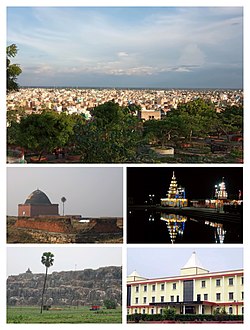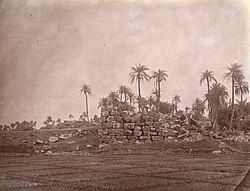This article needs additional citations for verification .(September 2015) |
Bihar Sharif | |
|---|---|
City | |
 Top to bottom: The City Skyline, Tomb of Ibrahim Baya, Mora Talab Temple, View of Peer Pahadi from NH 20, An institutional block at K. K. University | |
| Coordinates: 25°11′49″N85°31′05″E / 25.197°N 85.518°E | |
| Country | |
| State | |
| Division | Patna |
| District | Nalanda |
| Government | |
| • Type | Municipal Corporation |
| • Body | Bihar Sharif Municipal Corporation |
| • Member of Parliament | Kaushalendra Kumar |
| • District Magistrate | Kundan Kumar, [1] IAS |
| • Superintendent of Police, Nalanda | Bharat Soni, [1] IPS |
| • Municipal Commissioner | Deepak Kumar Mishra, [1] IAS |
| • Mayor | Aneeta Devi [2] |
| Area | |
• City | 152.94 km2 (59.05 sq mi) |
| • Urban | 23.5 km2 (9.1 sq mi) |
| • Regional planning [3] | 78.53 km2 (30.32 sq mi) |
| Elevation | 55 m (180 ft) |
| Population (2011) [4] | |
• City | 297,268 |
| • Density | 15,743/km2 (40,770/sq mi) |
| Language | |
| • Official | Hindi [5] |
| • Additional official | Urdu [5] |
| • Local | Magahi |
| Time zone | UTC+5:30 (IST) |
| PIN | 803101 803118 803216 803111 803113 |
| Telephone code | +916112 |
| ISO 3166 code | IN-BR |
| Vehicle registration | BR-21 |
| Loksabha Constituency | Nalanda (29) |
| Vidhan Sabha Constituency | Bihar Sharif (172) |
| Website | nagarseva.bihar.gov.in/biharsharif |
Bihar Sharif is the headquarters of Nalanda district and the fifth-largest sub-metropolitan area in the eastern Indian state of Bihar. Its name is a combination of two words: Bihar, derived from vihara (meaning monastery), also the name of the state; and Sharif (meaning noble). [6] The city is a hub of education and trade in southern Bihar, and the economy centers around agriculture supplemented by tourism, the education sector and household manufacturing. The ruins of the ancient Nalanda Mahavihara, a UNESCO World Heritage Site, are located near the city. [7]
Contents
- Etymology
- History
- Classical and medieval period
- Conquests and dynastic transitions
- Later history
- Modern period
- Geography
- Demographics
- Religion
- Administration
- Economy
- Culture and cityscape
- Heritage and important sites
- Events
- Transport
- Roadways
- Public transport
- Railways
- Airways
- Education
- Universities
- Colleges
- Media and entertainment
- In popular culture
- Notable people
- See also
- References
Under the Pala Empire, Odantapuri, a major Buddhist monastic university was built at the site of Bihar Sharif. In the early 14th century, the city was captured by the Delhi Sultanate. Bihar Sharif was later ruled by other Muslim dynasties and then by the British until Indian independence in 1947. The city has important Buddhist, Hindu and Muslim heritage sites and landmarks.
Bihar Sharif is one of the one hundred Indian cities selected to gain funds under Prime Minister Narendra Modi's flagship Smart Cities Mission. [8] [ needs update ] Bihar Sharif was selected in the preliminary list of 100 cities in July 2015 that were to compete for the Smart Cities project.
According to Ease of Living Index 2020, Bihar Sharif has been ranked as the most livable among cities in Bihar which have population under 1 million. [9] It was ranked 1st in Bihar and 28th among cities with a population under 1 million in India with an overall ranking of 63rd among 111 Indian cities. [10]











